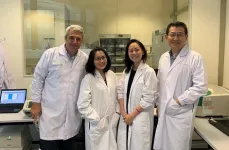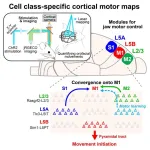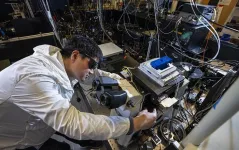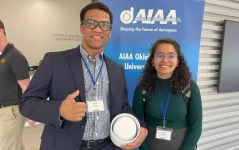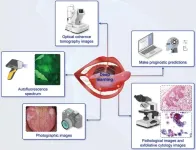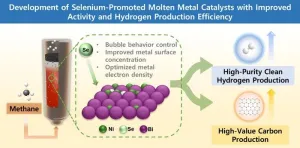(Press-News.org)
SINGAPORE – NalaGenetics, a spin-off from A*STAR Genome Institute of Singapore (A*STAR GIS), will be transforming leprosy treatments in Indonesia with a nationwide genetic screening programme with their PGx1301 diagnostic kit. Set to launch in the fourth quarter of 2025, this initiative builds on a successful five-year pilot test in East Indonesia, which demonstrated the effectiveness of precision medicine in preventing life-threatening adverse drug reactions (ADRs).
As part of this programme, up to 16,000 leprosy patients will be screened annually for the HLA-B*13:01 biomarker, a genetic variant linked to Dapsone Hypersensitivity Syndrome (DHS)—a severe and potentially fatal reaction to dapsone, a key antibiotic in leprosy treatment. This programme marks a significant step forward in global efforts to eliminate leprosy, a disease that continues to affect vulnerable populations in tropical regions.
A Milestone for Indonesia’s Healthcare System
Leprosy, or Hansen's disease, remains a global public health concern, with a global prevalence rate of 16.9 cases per million population[1]. This chronic infectious disease, caused by the bacteria Mycobacterium leprae or Mycobacterium lepromatosis, can lead to nerve damage and physical disabilities if left untreated.
The nationwide rollout of genetic screening represents a major milestone for Indonesia’s healthcare system. Since 2021, regional laboratories in Papua, Indonesia, have been screening all new leprosy patients using NalaGenetics’ test, resulting in near-zero cases of DHS, a condition that previously carried a 9.9% mortality risk among affected patients[2]. This success has prompted the Indonesian government to adopt the screening programme nationwide, setting a new precedent in precision medicine.
Putting Singapore on the Global Map of Precision Medicine
NalaGenetics’ journey began in 2016 with four co-founders from A*STAR GIS, including Dr Astrid Irwanto, Dr Levana Sani, Prof Liu Jianjun and Dr Alexander Lezhava, who came together to address a critical gap in healthcare: the lack of affordable and accessible genetic testing to prevent ADRs. With the support of A*STAR GIS, which licensed them the rapid, real-time PCR technology for genotyping, NalaGenetics was able to develop an affordable and accurate DNA diagnostic kit.
In 2018, NalaGenetics partnered with the Health Research Institute of the Ministry of Health in Papua, Indonesia, to run the first government-supported clinical trial for genetic screening in leprosy patients across three provinces and five districts[3]. The study confirmed that 20% of leprosy patients carried the biomarker, and no DHS cases were reported among those screened, proving the life-saving potential of genetic testing.
“This initiative is a testament to Singapore’s growing influence in the global precision medicine landscape,” said Dr Levana Sani, CEO of NalaGenetics. “By combining cutting-edge science with a deep understanding of regional healthcare needs, we’ve created a solution that not only saves lives but also sets a precedent for how genetic testing can be scaled in resource-limited settings.”
A Model for Global Health Innovation
NalaGenetics’ impact extends far beyond Indonesia. With support from the Netherlands Leprosy Relief and the Indonesian Ministry of Health, they expanded clinical trials to Nepal and India, validating the universal relevance of the HLA-B*13:01 biomarker in Asian populations. The success of NalaGenetics underscores Singapore’s commitment to translating scientific research into real-world solutions. These efforts have culminated in a peer-reviewed publication in PLOS Neglected Tropical Diseases, solidifying the scientific foundation for this life-saving intervention[4].
Dr Wan Yue, Executive Director of A*STAR GIS, said, “From the lab to the field, NalaGenetics exemplifies how A*STAR’s research can have a profound impact on global health. Their journey and achievements are a testimony to A*STAR’s commitment to grooming our talent to develop scientific research and translating our clinical research to benefit human health, not just in Singapore but also around the world.”
Prof Liu Jianjun, co-founder of NalaGenetics and Distinguished Principal Scientist at A*STAR GIS, said, “We are very excited that the Indonesian Government will implement the HLA-B*13-01 screening test nationwide with NalaGenetics’s affordable diagnostic test. While leprosy may not be prevalent in Singapore, our research has far-reaching implications for diseases that affect our region. By unlocking the potential of Asian genomics, we are improving health outcomes not just for Singaporeans but for millions across Asia.”
As NalaGenetics continues to expand its reach, they are also exploring applications of their genetic testing platform for other diseases, including cardiovascular conditions and diabetes. “Our vision is to make precision medicine accessible to all,” said Dr Sani. “By leveraging our expertise in genomics and data analytics, we aim to empower healthcare providers with the tools they need to deliver personalised, effective care.”
[1] Global leprosy (Hansen disease) update, 2021: moving towards interruption of transmission
[2] The New England Journal of Medicine. 2013 Oct 24;369(17):1620-8. DOI:10.1056/NEJMoa1213096
[3] Province (Districts): Papua (Jayapura), West Papua (Manokwari, South Manokwari), Southwest Papua (Sorong), South Papua (Asmat) and North Maluku (Ternate, West Halmahera, East Halmahera)
[4] Validation study of HLA-B*13:01 as a biomarker of dapsone hypersensitivity syndrome in leprosy patients in Indonesia, October 16, 2020. https://doi.org/10.1371/journal.pntd.0008746
END
For nearly a century, scientists have known that different parts of the human brain’s cortex control different body movements. This fundamental discovery dates to the 1930s, when neurosurgeons used electrical stimulation to map how different cortical regions correspond to different body parts.
But can these regions be further broken down into even smaller functional components? Researchers have long suspected that cortical units for specific body movements are more complex than simple patches in the cortex. Studies have identified various types of neurons stacked in multiple layers across the neocortex, but without a clear picture of how these ...
A research team co-led by Lawrence Berkeley National Laboratory (Berkeley Lab), Columbia University, and Universidad Autónoma de Madrid has developed a new optical computing material from photon avalanching nanoparticles.
The breakthrough – which the team published recently in the journal Nature Photonics – paves the way for fabricating optical memory and transistors on a nanometer size scale comparable to current microelectronics. This approach offers a path toward realizing smaller, faster components for next-generation ...
Colorectal cancer (CRC) is the second most commonly diagnosed cancer in China and a leading cause of cancer-related mortality. Despite improvements in treatment, the survival rate remains lower than in Western and other Asian countries due to late-stage diagnosis. Given that CRC typically develops over a prolonged period from precursor lesions, early detection and timely intervention are crucial for improving patient outcomes. However, CRC screening in China faces several challenges, including regional disparities, economic constraints, and limited public awareness. Recent advancements in non-invasive diagnostic tests, innovative imaging techniques, and ...
Aerospace engineering senior Philip Wilson attended an American Institute of Aeronautics and Astronautics (AIAA) conference. Rohit Raut, a senior physics major, presented his work at a nuclear research symposium, and senior biology major Jaden Rankin had the opportunity to feature her research at an entomology conference.
These and other University of Texas at Arlington students were able to showcase their original research at major symposiums thanks to UTA’s expansion of its popular undergraduate research program that provides funding for select students to present at academic conferences.
“At the conference, I presented my work on rotating ...
Oral cancer remains a serious global health concern due to its high morbidity and mortality rates, primarily caused by late-stage diagnosis. The presence of oral potentially malignant disorders (OPMDs) provides an opportunity for early intervention, as these lesions precede the development of oral squamous cell carcinoma. However, the accurate detection and classification of OPMDs remain challenging due to their diverse clinical presentations. Conventional diagnostic methods, including visual examination and histopathological ...
To develop a practical fusion power system, scientists need to fully understand how the plasma fuel interacts with its surroundings. The plasma is superheated, which means some of the atoms involved can strike the wall of the fusion vessel and become embedded. To keep the system working efficiently, it’s important to know how much fuel might be trapped.
“The less fuel is trapped in the wall, the less radioactive material builds up,” said Shota Abe, a staff research physicist at the U.S. Department of Energy’s (DOE) Princeton Plasma Physics Laboratory (PPPL).
Abe is the lead researcher on a new study published in Nuclear ...
The electrochemical reduction of CO2 has been recognized as a promising strategy to convert ambient atmospheric CO2 into valuable products. Bismuth-based catalysts have garnered the widespread attention of researchers due to their cost-effectiveness, low toxicity, and high natural abundance. Significant progress has been made toward enhancing the reactivity of catalyst structures through innovative synthesis techniques and engineering. Advances include the use of flow cells and membrane electrode assembly (MEA) cells to attain high cathodic current densities of over 200 mA cm-2 with superior ...
Researchers in South Korea have developed an advanced liquid metal catalyst incorporating selenium (Se) to enhance the efficiency of turquoise hydrogen production.
Turquoise hydrogen is generated via methane (CH₄) pyrolysis, producing hydrogen while yielding solid carbon as a byproduct, without emitting carbon dioxide (CO₂).
A research team led by Dr. Seung Ju Han at the Korea Research Institute of Chemical Technology (KRICT) has introduced selenium-doped molten metal catalysts (NiBi, CuBi) to significantly enhance methane pyrolysis efficiency. The technology demonstrates ...
A century of fire suppression, combined with global warming and drought, has led to increasingly destructive wildfires in the Western United States. Forest managers use tools like prescribed burns, thinning, mastication, and piling and burning to reduce fuel – live and dead trees, needles and leaves, and downed branches – that can feed intense wildfires. These methods aim to lower fuel levels, reduce crown density, and protect fire-resistant trees, fostering healthier, more resilient forests.
However, prescribed burning efforts haven’t kept up with the rapid buildup of surface fuel, creating a “fire deficit” – the gap between the amount of fuel that has ...
CLEVELAND—Researchers at Case Western Reserve University (CWRU) and University Hospitals (UH) will use state-of-the-art medical technologies they invented—and licensed to Lucid Diagnostics Inc.—to detect esophageal precancer, specifically Barrett’s Esophagus (BE).
BE is a change in the cellular structure of the esophageal lining typically caused by gastroesophageal reflux disease (GERD), also known as heartburn. The goal is to reduce the incidence of esophageal cancer (EAC).
EAC is a rare type of cancer with a high-morality rate—the cause of 2.6% of all cancer ...
